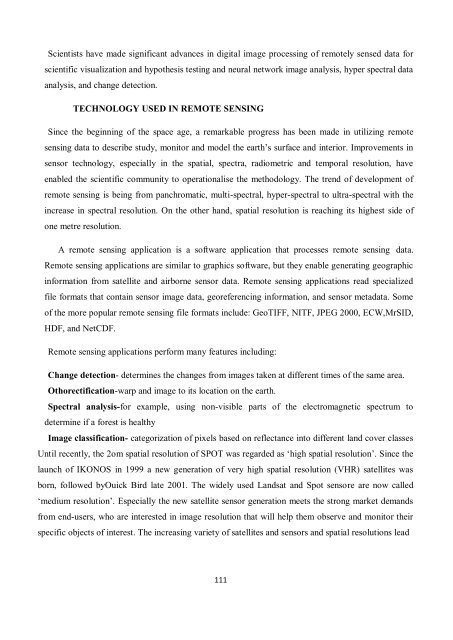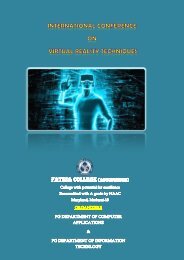combinepdf (5)
You also want an ePaper? Increase the reach of your titles
YUMPU automatically turns print PDFs into web optimized ePapers that Google loves.
Scientists have made significant advances in digital image processing of remotely sensed data for<br />
scientific visualization and hypothesis testing and neural network image analysis, hyper spectral data<br />
analysis, and change detection.<br />
TECHNOLOGY USED IN REMOTE SENSING<br />
Since the beginning of the space age, a remarkable progress has been made in utilizing remote<br />
sensing data to describe study, monitor and model the earth’s surface and interior. Improvements in<br />
sensor technology, especially in the spatial, spectra, radiometric and temporal resolution, have<br />
enabled the scientific community to operationalise the methodology. The trend of development of<br />
remote sensing is being from panchromatic, multi-spectral, hyper-spectral to ultra-spectral with the<br />
increase in spectral resolution. On the other hand, spatial resolution is reaching its highest side of<br />
one metre resolution.<br />
A remote sensing application is a software application that processes remote sensing data.<br />
Remote sensing applications are similar to graphics software, but they enable generating geographic<br />
information from satellite and airborne sensor data. Remote sensing applications read specialized<br />
file formats that contain sensor image data, georeferencing information, and sensor metadata. Some<br />
of the more popular remote sensing file formats include: GeoTIFF, NITF, JPEG 2000, ECW,MrSID,<br />
HDF, and NetCDF.<br />
Remote sensing applications perform many features including:<br />
Change detection- determines the changes from images taken at different times of the same area.<br />
Othorectification-warp and image to its location on the earth.<br />
Spectral analysis-for example, using non-visible parts of the electromagnetic spectrum to<br />
determine if a forest is healthy<br />
Image classification- categorization of pixels based on reflectance into different land cover classes<br />
Until recently, the 2om spatial resolution of SPOT was regarded as ‘high spatial resolution’. Since the<br />
launch of IKONOS in 1999 a new generation of very high spatial resolution (VHR) satellites was<br />
born, followed byOuick Bird late 2001. The widely used Landsat and Spot sensore are now called<br />
‘medium resolution’. Especially the new satellite sensor generation meets the strong market demands<br />
from end-users, who are interested in image resolution that will help them observe and monitor their<br />
specific objects of interest. The increasing variety of satellites and sensors and spatial resolutions lead<br />
111




